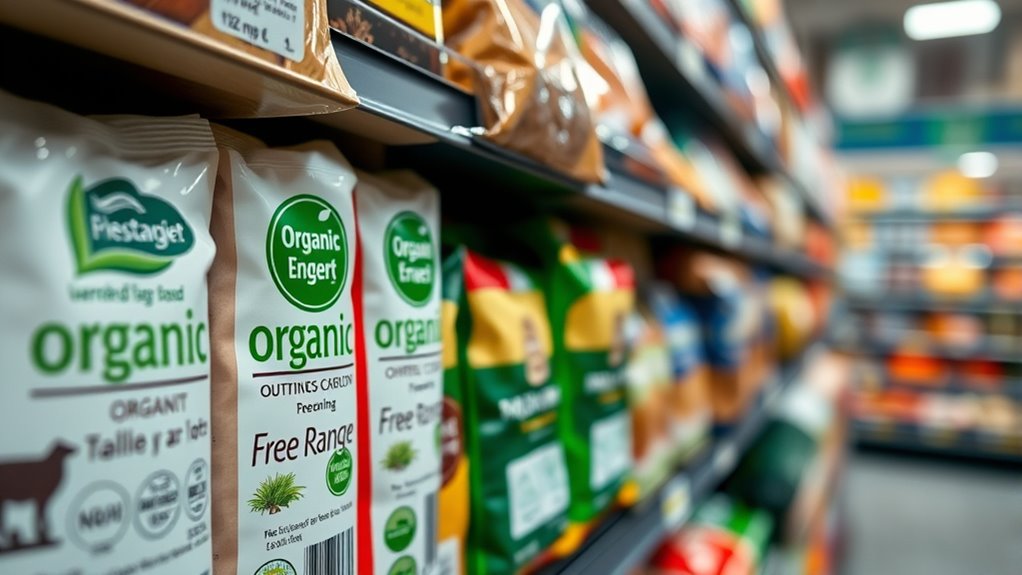Understanding food labels helps you see how your food is made and whether it meets specific standards. Labels like “organic” mean no synthetic pesticides or GMOs, while “free-range” and “pasture-raised” suggest animals live outdoors in better conditions. Certification icons verify these claims, ensuring transparency and trust. By recognizing these labels and their meanings, you can make choices aligned with your health and values—keep exploring to learn more about what each label signifies.
Key Takeaways
- Organic labels indicate production without synthetic pesticides, fertilizers, or GMOs, ensuring chemical-free and sustainable farming practices.
- “Free-range” and “pasture-raised” labels signify animals have outdoor access, reflecting better welfare and humane treatment standards.
- Certification labels like USDA Organic involve rigorous inspection processes to verify compliance with safety, environmental, and animal welfare standards.
- Food labels help consumers identify ethical, environmental, and health-related qualities, guiding healthier and more responsible purchasing choices.
- Packaging design, including color and clarity, influences perception and trust, reinforcing label claims and making standards easier to understand.

Reading food labels can seem overwhelming at first, but understanding what they mean is essential for making healthier choices. When you see labels like “organic,” “free-range,” or “grass-fed,” it’s helpful to know what standards back those claims. Certification labels often reflect compliance with specific regulations, including pesticide regulations that govern how crops are grown and animal welfare standards that set the bar for humane treatment of farm animals. These labels aren’t just marketing jargon; they’re indicators of how your food was produced and what you’re supporting with your purchase.
Organic labels, for example, indicate that the food was produced without synthetic pesticides, fertilizers, or genetically modified organisms (GMOs). This means farmers had to adhere to strict pesticide regulations that limit the use of harmful chemicals, reducing your exposure to residues that can linger on conventional produce. Moreover, organic standards often include animal welfare standards, requiring livestock to have access to outdoor spaces, clean living conditions, and humane treatment. This not only benefits the animals but can also influence the quality and nutritional value of the food you eat.
Organic labels ensure foods are free from synthetic pesticides, fertilizers, GMOs, and promote animal welfare standards.
When you see “free-range” or “pasture-raised,” it’s a sign that the animals had access to the outdoors and more natural living conditions. While these labels are generally associated with better animal welfare standards, it’s worth noting that the specifics can vary depending on the certifying organization. Still, these practices align with policies emphasizing humane treatment, which can also impact the taste and nutritional profile of the meat or eggs. Knowing these distinctions helps you choose products that align with your values and health priorities.
Understanding food labels also involves recognizing the importance of certification organizations that enforce these standards. Reputable labels undergo rigorous inspection, ensuring compliance with pesticide regulations and animal welfare standards. For instance, the USDA Organic label not only guarantees the absence of synthetic chemicals but also confirms that farmers follow sustainable practices that minimize environmental impact. This transparency allows you to make informed decisions, supporting farmers and suppliers committed to ethical and environmentally friendly practices.
Additionally, the role of color accuracy and contrast ratio in food packaging design can influence consumer perceptions and choices by highlighting key product features and benefits.
Frequently Asked Questions
How Do Organic Labels Differ Internationally?
International standards and labeling regulations vary, so organic labels differ depending on where you are. In some countries, strict rules require certification by recognized agencies, ensuring products meet specific organic criteria. Elsewhere, standards may be less strict or loosely enforced, affecting label credibility. Always check the certification or governing body referenced on the label to verify if it aligns with your country’s organic standards, ensuring you get truly organic products wherever you shop.
Are Free-Range Eggs More Nutritious Than Caged Ones?
Think of free-range eggs as a gust of fresh air compared to caged ones. They often pack more nutritional differences—like higher omega-3s—and reflect better animal welfare. With more space to roam, hens produce eggs with richer nutrients and happier lives. So, yes, free-range eggs are generally more nutritious and kinder to animals, making them a choice that benefits both your health and ethical standards.
Can Processed Foods Be Labeled Organic?
Yes, processed foods can be labeled organic if they meet strict standards. This means they’re made using organic farming practices that limit pesticide residues and avoid synthetic additives. However, check the label carefully because processing can sometimes conceal non-organic ingredients. Your best bet is to look for certified organic labels, which ensure farming practices focus on reducing pesticide residues and maintaining natural integrity throughout the production process.
What Certifications Verify Free-Range Claims?
Think of free-range claims as a badge of honor for poultry farms. You can verify these claims through certification standards like the USDA’s Process Verified Program or Animal Welfare Approved, which rely on thorough poultry farm inspections. These certifications guarantee the farm allows chickens outdoor access, confirming their free-range status. Always look for these trusted labels to ensure your eggs and poultry meet genuine free-range standards.
Do Organic Foods Have a Longer Shelf Life?
Organic foods often have a similar or slightly shorter shelf life compared to conventional products because they typically lack synthetic preservatives. Preservation methods like refrigeration, vacuum sealing, or freezing help extend their freshness. To maximize shelf life, you should store organic items properly and check expiration dates regularly. While organic foods prioritize natural ingredients, their shelf life depends more on preservation techniques than on certification standards.
Conclusion
By understanding food labels like organic and free-range, you can make better choices for your health and the environment. Did you know that sales of organic products have grown by over 12% annually in recent years? This shows a rising awareness among consumers. So next time you shop, take a moment to read those labels—you’ll feel more confident about what you’re eating and how it impacts the world around you. Your informed choices truly make a difference.









